Ben Hogans Release And How You're Never Going To Get It
- by Kelvin Miyahira
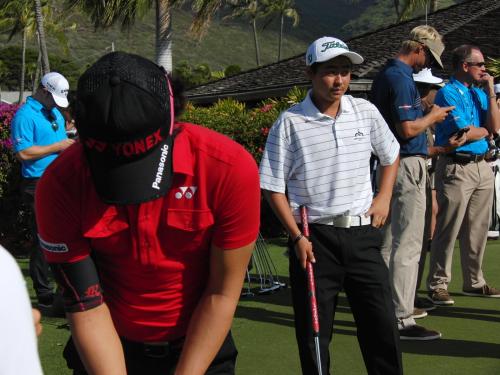
Congratulations to Johnny Oda for qualifying for the Sony Open at 15 years old and despite fighting his nerves, he played two solid rounds shooting 73-73. Although he missed the cut, he gained much valuable experience playing with the veterans Rocco Mediate, William McGirt, Chad Collins and Shane Bertsch in the practice rounds then playing with young up ‘n comers Jonas Blixt and Kyle Reifers in his first two rounds. At 5’ 6 ½” tall, he was out there bombing it with them and in the first round averaged 305.5 yards on his drives according to Shotracker.
No, You’re Never Going To Get It
Combine the absence of high speed video of his swing, his secretive nature and the possibility that he led everyone on a wild goose chase; everyone is left to guess how Ben Hogan actually struck the ball. The fascination with how he swung the club differently and hit the ball so far and straight enchants many golfing enthusiasts with few ever getting close to copying his swing. But anatomical knowledge and the ability to characterize the distinctive movements of golfers might allow one to learn how he actually hit the ball and therefore allow anyone to learn to strike it just as he did. But you’ve got to pay attention to the details.
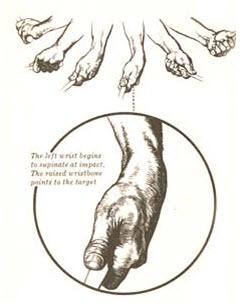
First, a few anatomical definitions. Supination of the forearm is turning the palm up; pronation of the forearm is turning the palm down. Flexion of the wrist is a bowing or arching of the wrist; extending is bending or cupping the wrist. Radial deviation is cocking the wrist (moving the thumb toward the forearm); ulnar deviation is an uncocked wrist (moving the thumb away from the forearm).
Also, what might be confusing is the arm will be upside down on the finish of the swing so supination will actually result in the palm facing down and pronation will cause the palm to face up. Just remember that the forearm rotation and position will be the same but upside down.
The above illustration from Hogan’s Five Lessons shows supination and flexion of the left wrist at impact. But the sequence pictures above it seem to show a rolling release or continuous supination and retention of left wrist flexion through impact. Is this what Hogan did?
I once read a book called Drawing on the Right Side of Your Brain. One of the tricks they use is to look at a picture upside down in order to really see what an object looks like and therefore be able to draw it as an artist sees it. Since the thought of looking at a swing upside down isn’t too appealing, let’s look at Hogan’s swing in reverse order from the finish position and work backwards to before impact in order to look for clues as to the actual movements. This might help your brain understand what’s going on in a different light.

On the left we see the famous Hogan follow through. Notice where the back of his left hand is pointing. It is pointing directly back toward the camera. Jeffy’s is pointing to the left. Notice also the roughly 90 degree difference in the finish position of the clubface. For now, let’s not make assumptions of how this difference in clubface orientation occurred. Just know that there’s a difference.

At this position we see other differences.
Right Wrist/Forearm
Hogan has a bowed or arched right wrist. It is in an ulnar deviated, flexed and supinated forearm position (upside down). Contrast to Jeffy’s radial deviated, less flexed (flat position) and pronated forearm (upside down).
Left Wrist/Forearm
Hogan’s left wrist appears more extended (cupped) while being more pronated. Jeffy’s left wrist looks less extended (cupped) and more supinated.

Here Hogan’s clubface is not as closed or rotated counter-clockwise as much as Jeffy’s. The shaft is also lower and more to the left than Jeffy’s.

There is a huge gap in pictures since cameras could not shoot with high frame rates back in the 1960s when the Hogan stills were taken. So there’s a huge gap in knowledge here. But there can be some assumptions made.
Prior to contact, Hogan already has his left forearm supinated (rotated palm up), which closes the clubface, and the left wrist flexed (bowed) while Jeffy has his clubface more open and left wrist extended (cupped). Wouldn’t this mean that Jeffy needs a faster rate of closure than Hogan if he wants to get to the same supinated and bowed position at impact? And might not Jeffy’s faster rate of closure be reflected in his anatomical and clubface positions in the follow-through?

Remember the follow through position of Hogan vs. Jeffy from target line view and the difference in clubface angle? Hogan’s was much more open than Jeffy’s. From the front view, Hogan’s is also more open than Trevor Immelman’s.

In the picture above, why do we see more of Trevor’s left hand (at the red arrow)?
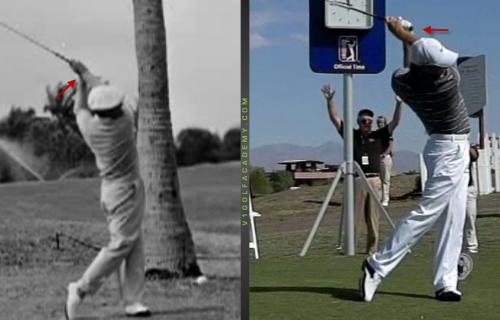
Why is Hogan’s left hand on opposite side of the right wrist from where Trevor’s is? Do Trevor’s hands look twisted over?

Sure do.
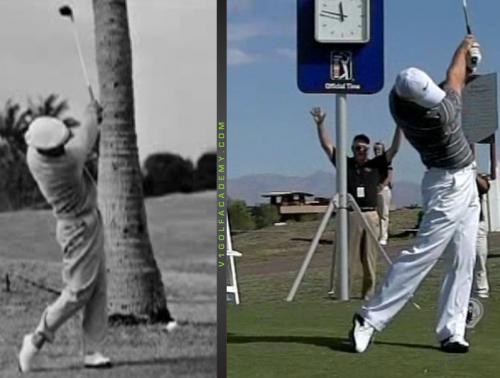
Trevor’s are definitely twisted over here.
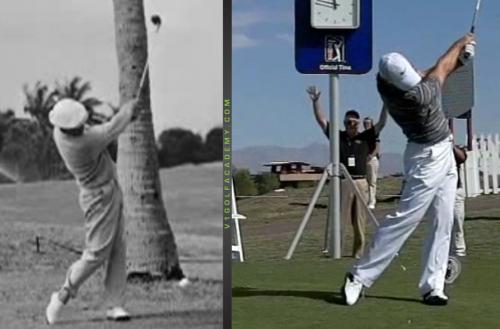
And here.
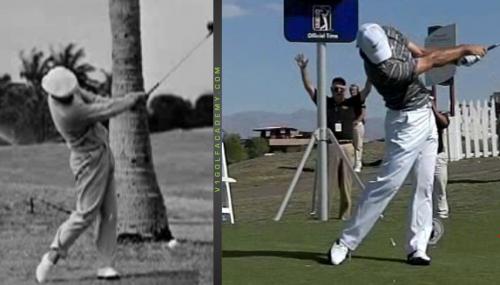
At this position, you just cannot tell what’s happening for sure, but it does look like Trevor has more roll-over of his forearms than Hogan.
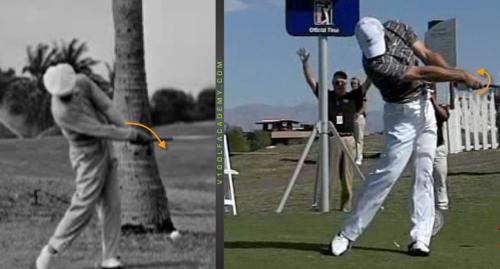
Here, Hogan has more ulnar deviation (UD) than Trevor, which impedes forearm rotation. Trevor has some UD but definitely more right forearm pronation, or rolling over.
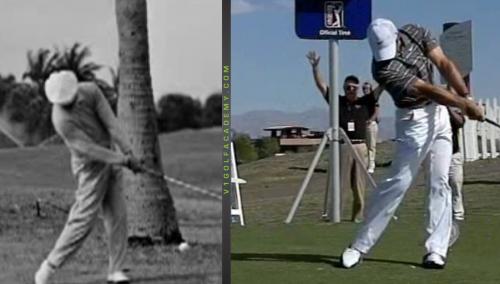
Can’t tell much difference here.
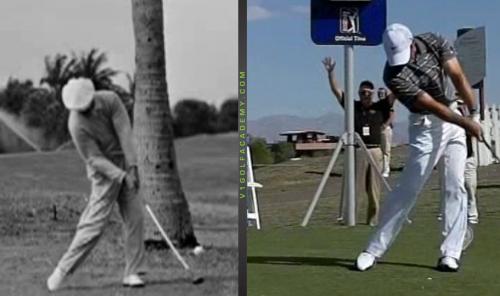
Looks similar here.
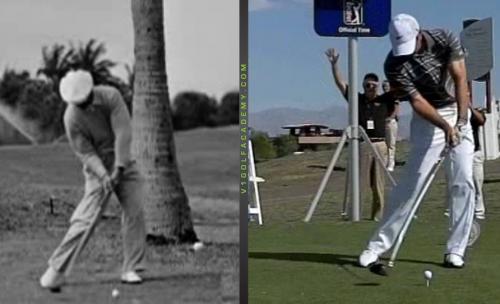
Very similar.
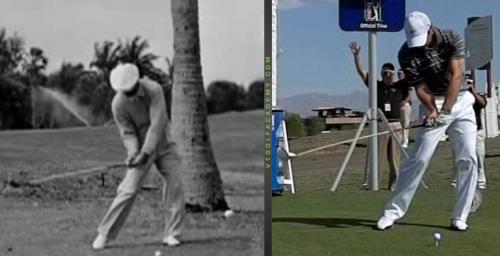
Trevor’s clubface looks more open at this point.
So working backwards, even though Hogan and Trevor had similar appearances just before and after impact, we can see that Trevor and Jeffy’s arms and clubface had a much greater range of motion open-to-closed from waist high in the downswing to the finish. In light of this, is it at all possible that either Jeffy or Trevor have the same release pattern as Hogan? I think not.
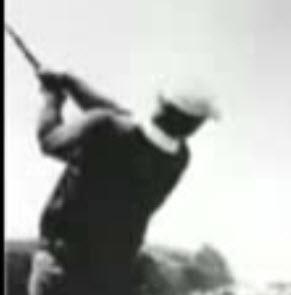
The key difference is that Hogan may have been wide open at the top of his backswing but he closed his clubface much earlier in the downswing (through supination of left forearm) and used right wrist flexion, supination and ulnar deviation (seen from target line view) to impede any more clubface rotation thereafter. Some have coined this method a “closed to open” release pattern. I think it is appropriate in Hogan’s case.
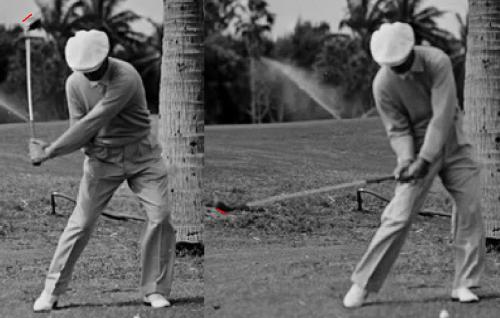
Hogan’s clubface goes from quite an open position on the left to closing early via supination of the left forearm.
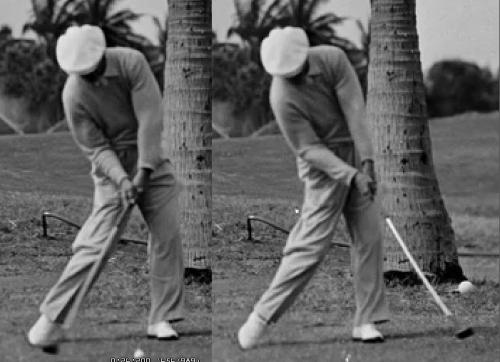

Look how square the clubface is just before impact! Early supination of the left forearm and left wrist flexion are apparent. Post-impact compare with Philly’s closed clubface. Hogan’s right hand is holding more extension (cupping) and less rolled into pronation than Phil. Awkward looking stall by Phil too. It is another trait of those that must perfectly time their rapid rolling release.

Here’s Tiger from the early days hitting a punch shot. You think Tiger knew how to do this?


As to the depiction in Five Lessons of continuous supination and flexion of the left wrist, it would have been impossible for Hogan to continuously supinate his left forearm from prior to impact into the follow through and wind up in the position shown above. On the right is Rocco Mediate showing the result of continuously supinating the left forearm into the follow-through. Notice how Rocco has his humerus pointed down by about 45 degrees while Hogan’s is parallel to the ground.. This shows that if you continuously supinate the left arm in the follow-through, the left shoulder must externally rotate and the arm will flex or bend accordingly. Hogan’s left shoulder and arm don’t do that.
Three Right Hands
Also, Hogan mentions that he wished he had three right hands. So obviously he wanted to hit with his right hand but how was this done? Can you hit the small fade with a fast rolling release using left forearm supination? Might be difficult. So Hogan obviously used his tremendous lag along with movements toward right wrist flexion, supination and ulnar deviation to slow the rate of closure once the clubface was close to square. Notice I did not say they were in that position at impact. That would define a flip. From a good lag position would be extended (holding right wrist cupped angle) and moving to less extended.
See this slow motion of Tommy Gainey’s hands moving through impact to understand the right hand. The right hand releases without rolling. It is also moving from pronated (palm down) to slightly supinated (palm up).
If you’ll try to put yourself in a good lag position, then try to feel these three movements of the right hand, they will actually work to open the clubface through impact. But this is not traditional way the release is taught. It’s always been open to closed and that you should roll the right hand/forearm over. See below.
Simply put, Hogan supinated the left forearm early, squared the clubface well before impact and hit with his right hand in a way that slowed clubface closure rate. If Hogan hit it like Jonas Blixt in above video, could he hit it as hard as he could? Would he want three right hands to create a faster rate of closure and therefore a hook?
So the question is, do you do as is written in Five Lessons, or do as Hogan actually did? Could it be that by studiously following Five Lessons, it is impossible to wind up swinging like Hogan? Maybe you can copy Hogan’s backswing. Maybe you can copy his finish. But if you don’t copy his impact zone dynamics (termed coined by Dr. Calvin Nii for tennis), you won’t ever hit shots like Hogan. Perhaps that is why so few, if any, Five Lessons followers developed swings that really looked like his in the impact zone.

